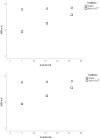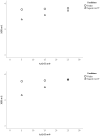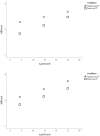Baseline Psychological Inflexibility Moderates the Outcome Pain Interference in a Randomized Controlled Trial on Internet-based Acceptance and Commitment Therapy for Chronic Pain
- PMID: 30585216
- PMCID: PMC6352262
- DOI: 10.3390/jcm8010024
Baseline Psychological Inflexibility Moderates the Outcome Pain Interference in a Randomized Controlled Trial on Internet-based Acceptance and Commitment Therapy for Chronic Pain
Abstract
This study re-investigated data of a randomized controlled trial on Internet-based Acceptance and Commitment Therapy for chronic pain (ACTonPain). Baseline psychological inflexibility was examined as a moderator of the outcome pain interference. In the ACTonPain trial, participants with chronic pain were randomized to one of three conditions: guided Internet-based ACT (n = 100), unguided Internet-based ACT (n = 101), and waitlist (n = 101). Moderation analyses were performed with the SPSS macro PROCESS. Pain interference according to the Multidimensional Pain Inventory (MPI) was the primary outcome in this trial, and the potential moderator psychological inflexibility was measured with the Acceptance and Action Questionnaire (AAQ-II). Psychological inflexibility at baseline moderated the outcome between guided Internet-based ACT and waitlist 9-weeks as well as 6-months after randomization. (both p < 0.05). Between unguided Internet-based ACT and waitlist, psychological inflexibility moderated the outcome 6-months after randomization (p < 0.05). Internet-based ACT was superior to waitlist for participants with less psychological inflexibility at baseline, but Internet-based ACT became increasingly comparable to waitlist at higher AAQ-II baseline values. Future research should investigate whether the results can be replicated in more individualized and tailored face-to-face settings.
Keywords: acceptance and commitment therapy; chronic pain; psychological inflexibility.
Conflict of interest statement
H. Baumeister reports that he is a psychological psychotherapist and consultant of the German chamber for psychotherapists in the last years. Moreover, he gives (paid) lectures and workshops on Internet- and mobile-based interventions. The remaining authors have no conflict of interest to declare.
Figures



References
-
- GBD 2016 Disease and Injury Incidence and Prevalence Collaborators Global, Regional, and National Incidence, Prevalence, and Years Lived with Disability for 328 Diseases and Injuries for 195 Countries, 1990–2016: A Systematic Analysis for the Global Burden of Disease Study 2016. Lancet. 2017;390:1211–1259. doi: 10.1016/S0140-6736(17)32154-2. - DOI - PMC - PubMed
LinkOut - more resources
Full Text Sources

